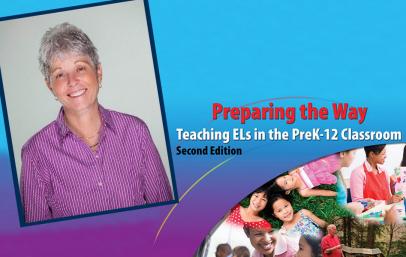ESOL in Higher Ed
April 13, 2017
 By: Guest Author: Jane M. Govoni, Ph.D.
By: Guest Author: Jane M. Govoni, Ph.D.
In “Preparing the Way: Teaching ELs in the PreK -12 Classroom” (3rd Ed.), the authors talk about a student named Peyton who speaks several languages. Her grandmother speaks Spanish; her father and paternal grandfather speak Polish, and her mother speaks English. Upon Peyton’s arrival into the world, she was consistently spoken and read to by her respective relatives. When Peyton began Kindergarten, she spoke at an age appropriate developmental level. She was able to communicate with her peers without any noticeable differences in speech patterns or comprehension. However, her favorite language was Spanish and at first, she attempted to use only this language. Her teacher, Ms. Gerrior, noticed that Peyton followed along in class well. She socialized with others in a quiet but comfortable manner and seemed to greatly enjoy P.E., music, and art. Even though she was settling into Kindergarten well, Ms. Gerrior reviewed Peyton’s school file. She soon discovered that Peyton was trilingual at 5 years old. She also learned that there were several other students whose first language was not English. Ms. Gerrior’s class consisted of seven ELs whose parents immigrated from South America, Korea, and China (both Cantonese and Mandarin languages); along with four special needs students and nine other kindergartners. Some of these ELs were born in the United States and spoke at least one other language. Peyton was the exception in speaking more than two languages at home.
Her teacher, Ms. Gerrior soon understood that she would have quite a diverse group of students this academic year and she would need to connect students’ languages and cultural backgrounds to lessons and activities. She considered possible gaps such as, school-readiness, academic achievement, and cultural and linguistic differences. Research shows that each of these factors plays a significant role in teaching and learning. She realized the more informed she was about students’ prior schooling experiences, the more success she would have in meeting their needs. Studies show that there is an academic advantage for students who speak more than one language over monolingual students. There are approximately five million students whose first language is not English across the nation. Most are born in the United States and represent about 10% of the student population. One in four students is not fluent in English. Legislation mandates that ELs are identified; instruction is research-based and effective for all levels of English proficiency; parents are informed of the reasons why children are identified as English learners, their level of English proficiency, how this was assessed, and what will be done to meet their needs. However, despite federal and state regulations to advocate for these students and their families; there remains a gap inadequate teacher training across the nation.
Learning is more meaningful when ELs make connections to what is going on in the classroom to their own lives. They come from diverse ethnic, cultural, linguistic, educational, and socioeconomic backgrounds; yet, they typically yearn to be actively engaged in class activities. Teachers, like Ms. Gerrior, face academic and language challenges almost daily, but their commitment to getting to know the sociocultural backgrounds of all students makes a difference. The cultural differences of Ms. Gerrior’s students define the foundation for instructional and assessment practices. Scaffolding, providing reading materials ahead of time, working closely with families, providing academic content words, promoting home languages, and other meaningful strategies are possible suggestions.
For this Kindergartener, Peyton, her cultural and language upbringing is all she knows. She will learn more in school as she continues to actively participate in activities with her classmates, teachers, and members of her school community. Right now, Peyton only knows what her family has taught her. Peyton’s cultural and linguistic background will expand as she is extended other experiences within the school community. She, along with the other ELs, have much to offer others; just as other students have much to offer ELs. It is the role of every teacher to foster this rich and meaningful experience across all content areas and grade levels.
Check out the 3rd upcoming edition of Preparing the Way: Teaching ELs in the Pre-K-12 Classroom by Kendall Hunt Publishing.
